Quick Burmese Chicken Curry
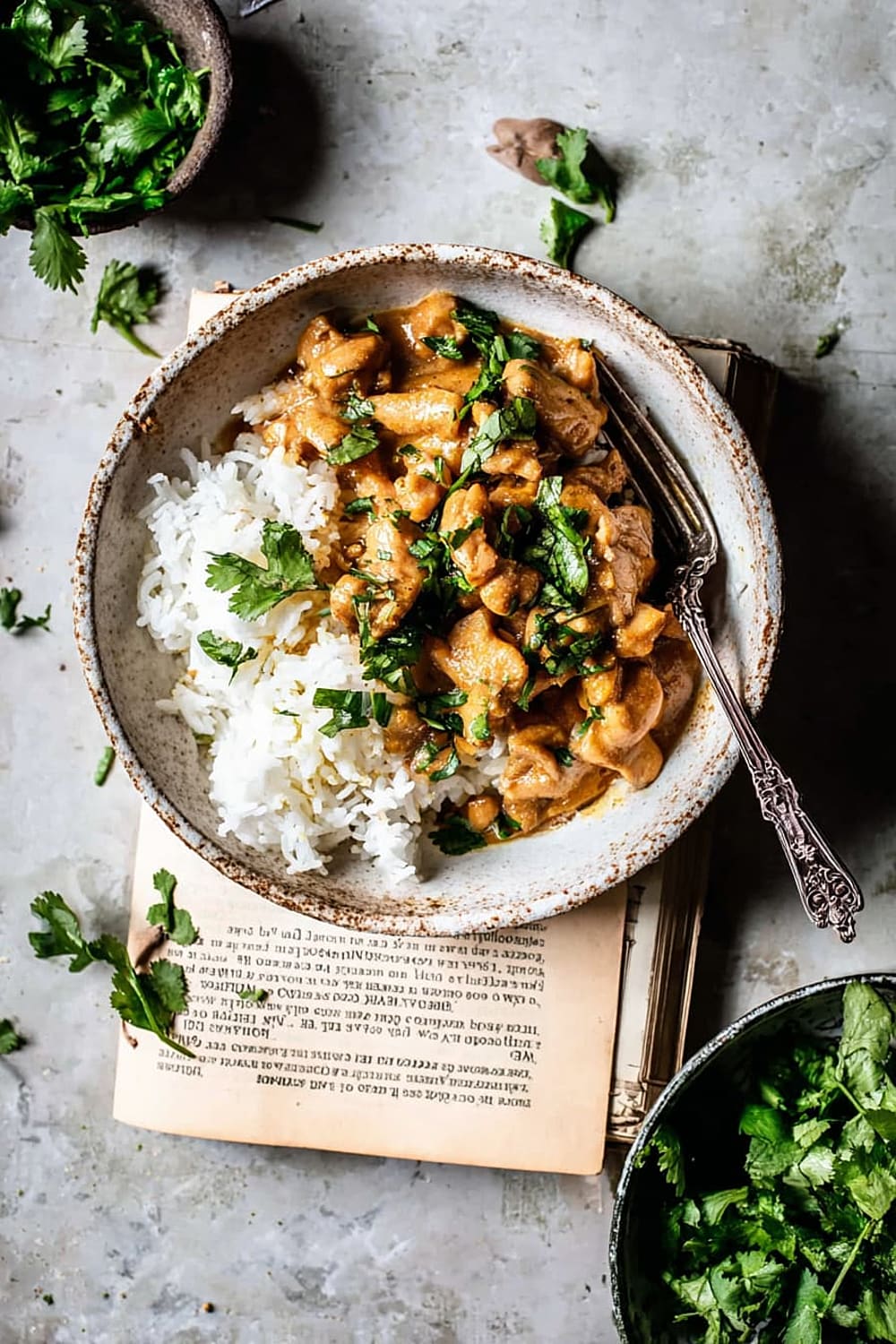
This curry is what happens when Southeast Asian flavors decide to throw a party in your kitchen, and everyone’s invited.
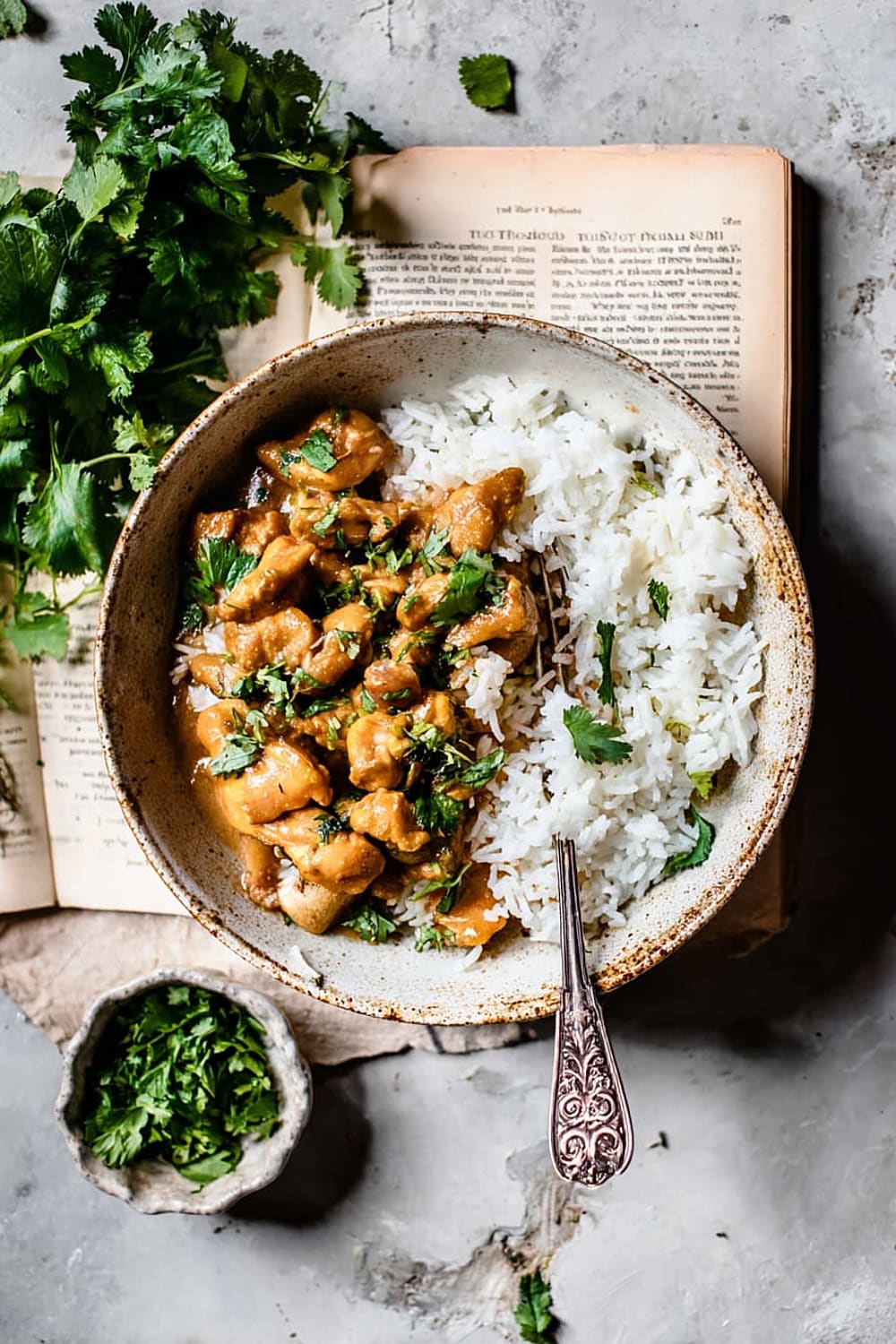
Imagine tender chicken thighs swimming in a fragrant, golden sauce that’s been kissed by lemongrass, ginger, and just enough spice to make your taste buds do a happy dance.
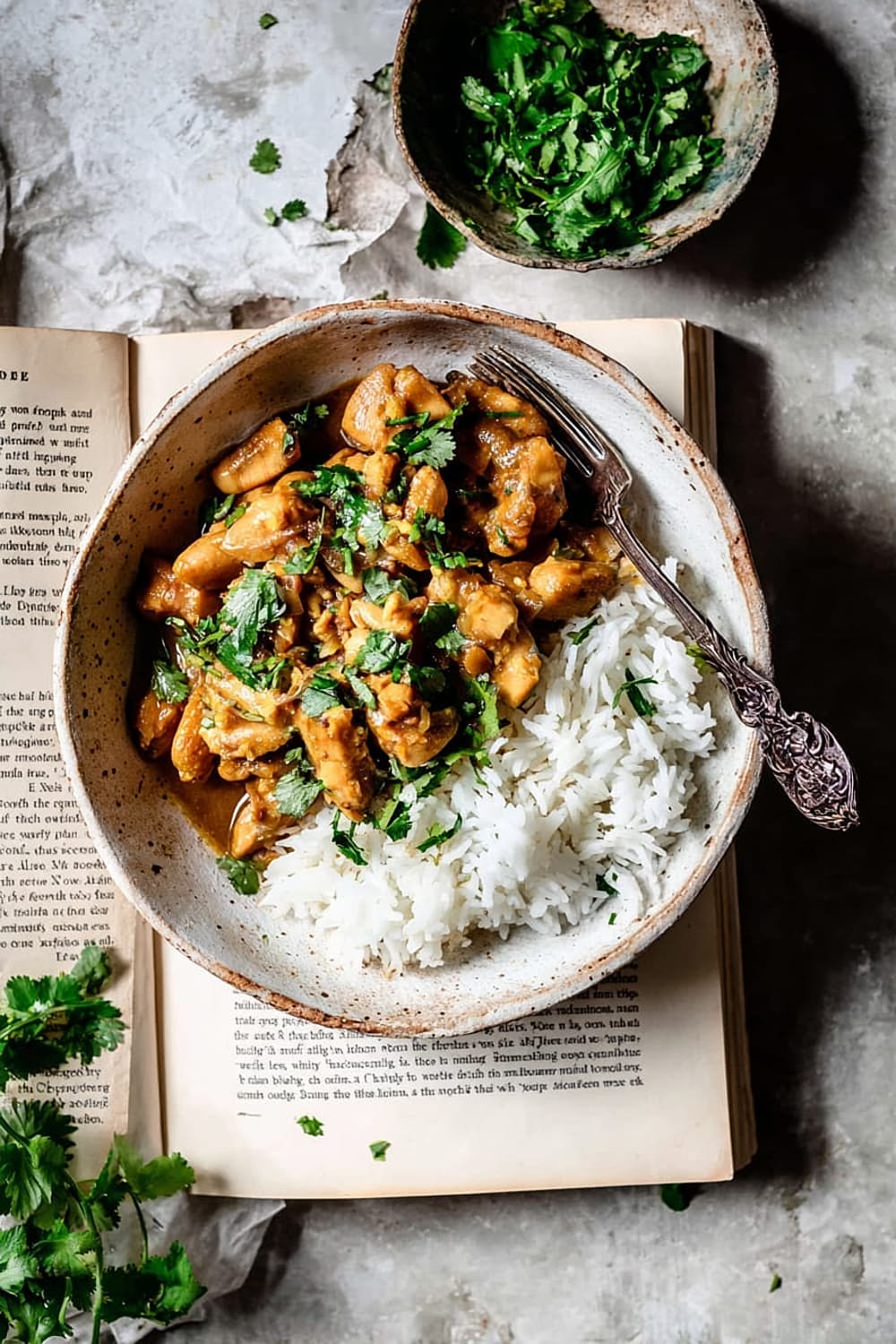
The best part about this recipe is that it tastes like you’ve been simmering it all day, but really it comes together faster than you can say “takeout.”
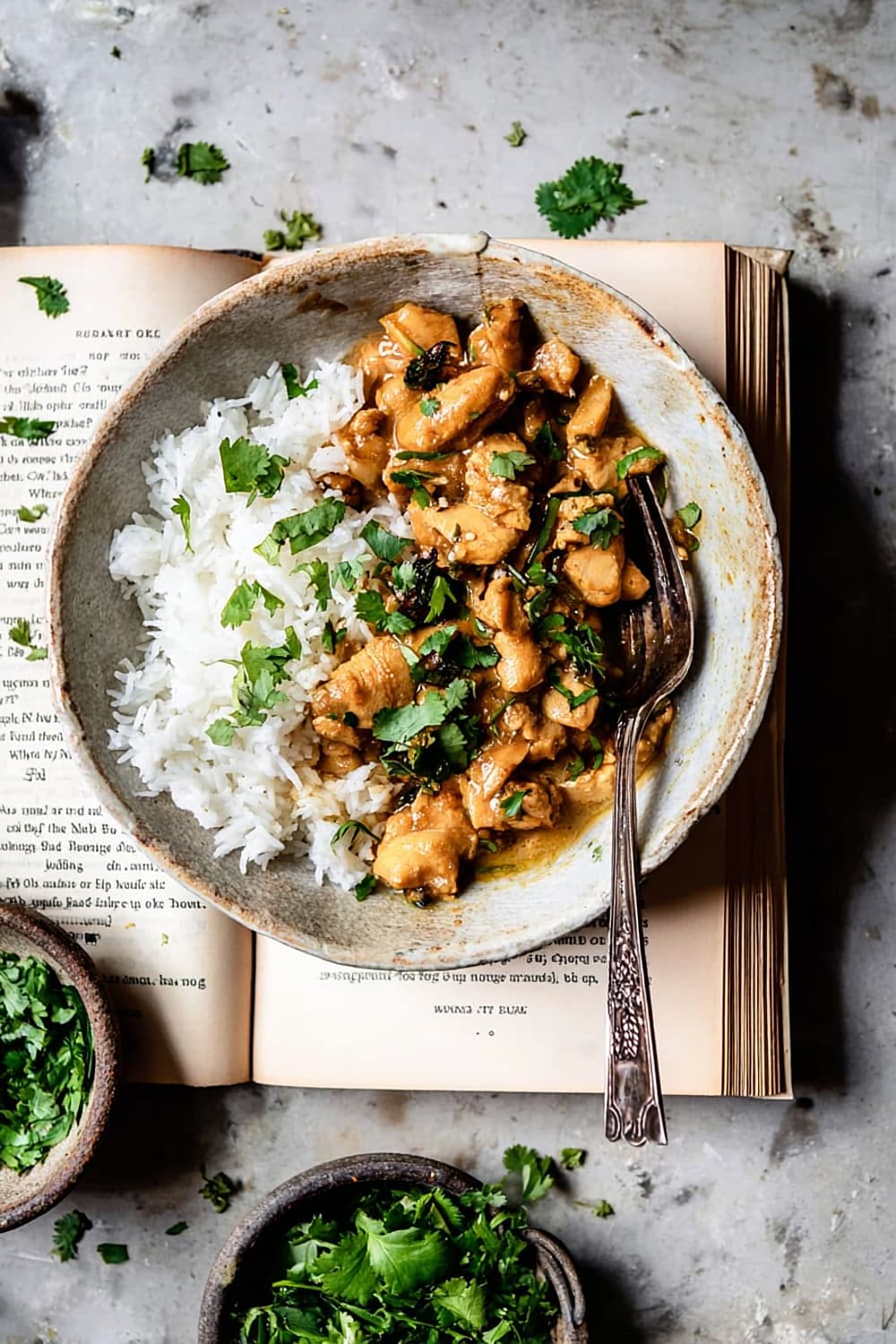
We’re talking about a curry that’s aromatic enough to make your neighbors suddenly very friendly, with layers of flavor that’ll have people convinced you’re some kind of culinary genius.
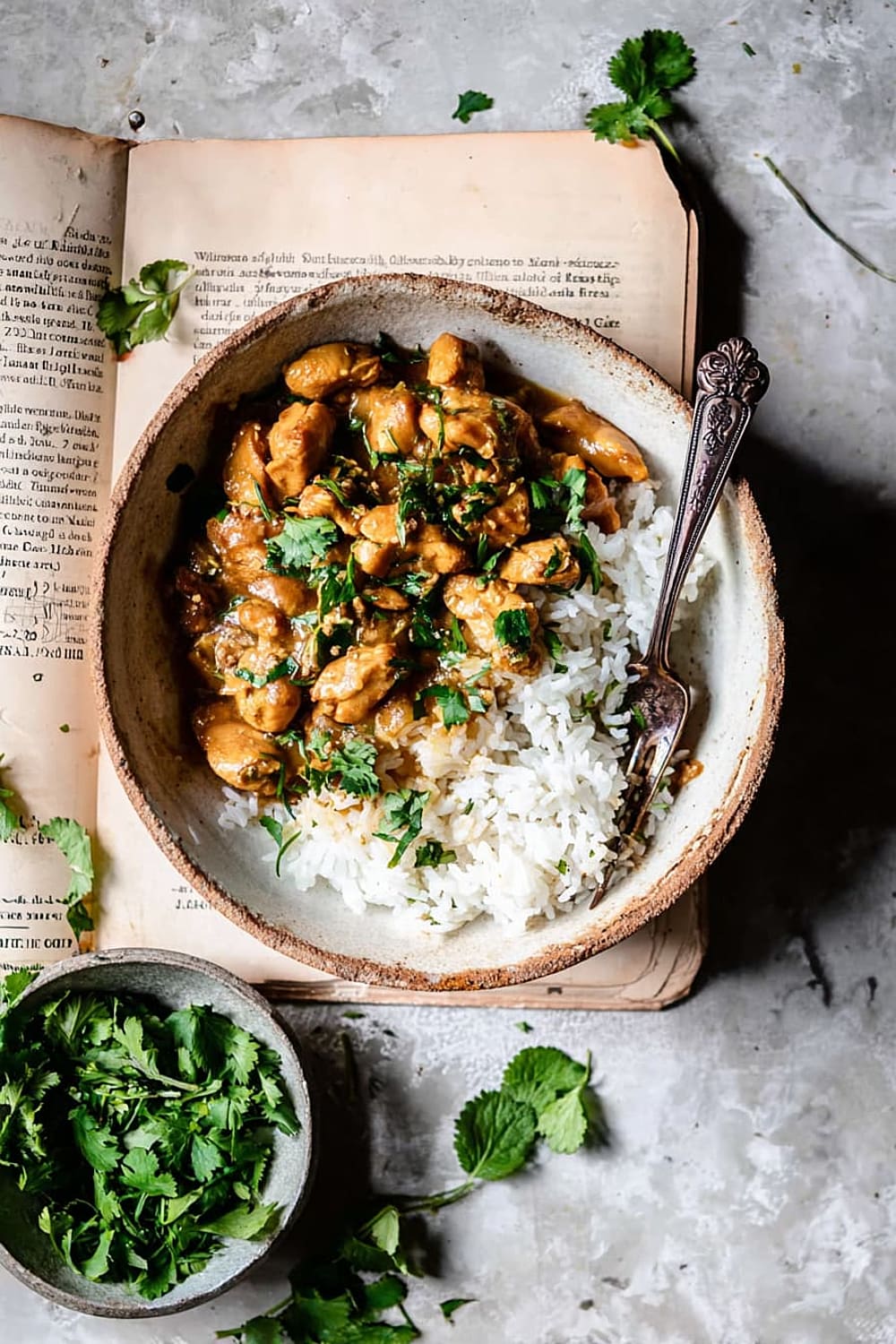
The coconut milk creates this velvety richness that perfectly balances the bright, citrusy notes from the lemongrass and the warm earthiness of garam masala.
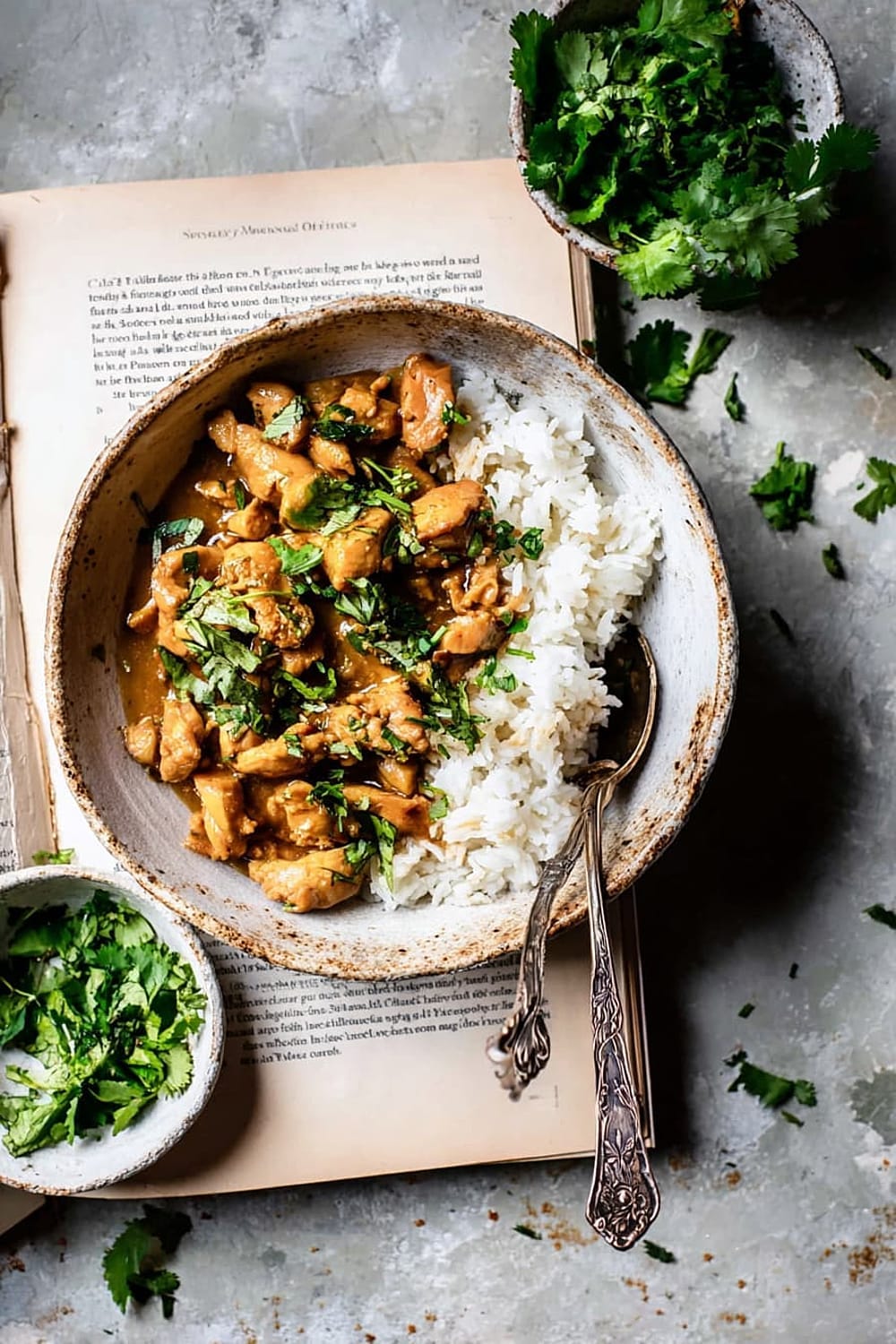
Plus, it’s the kind of one-pan wonder that makes cleanup almost as satisfying as the eating part – almost.
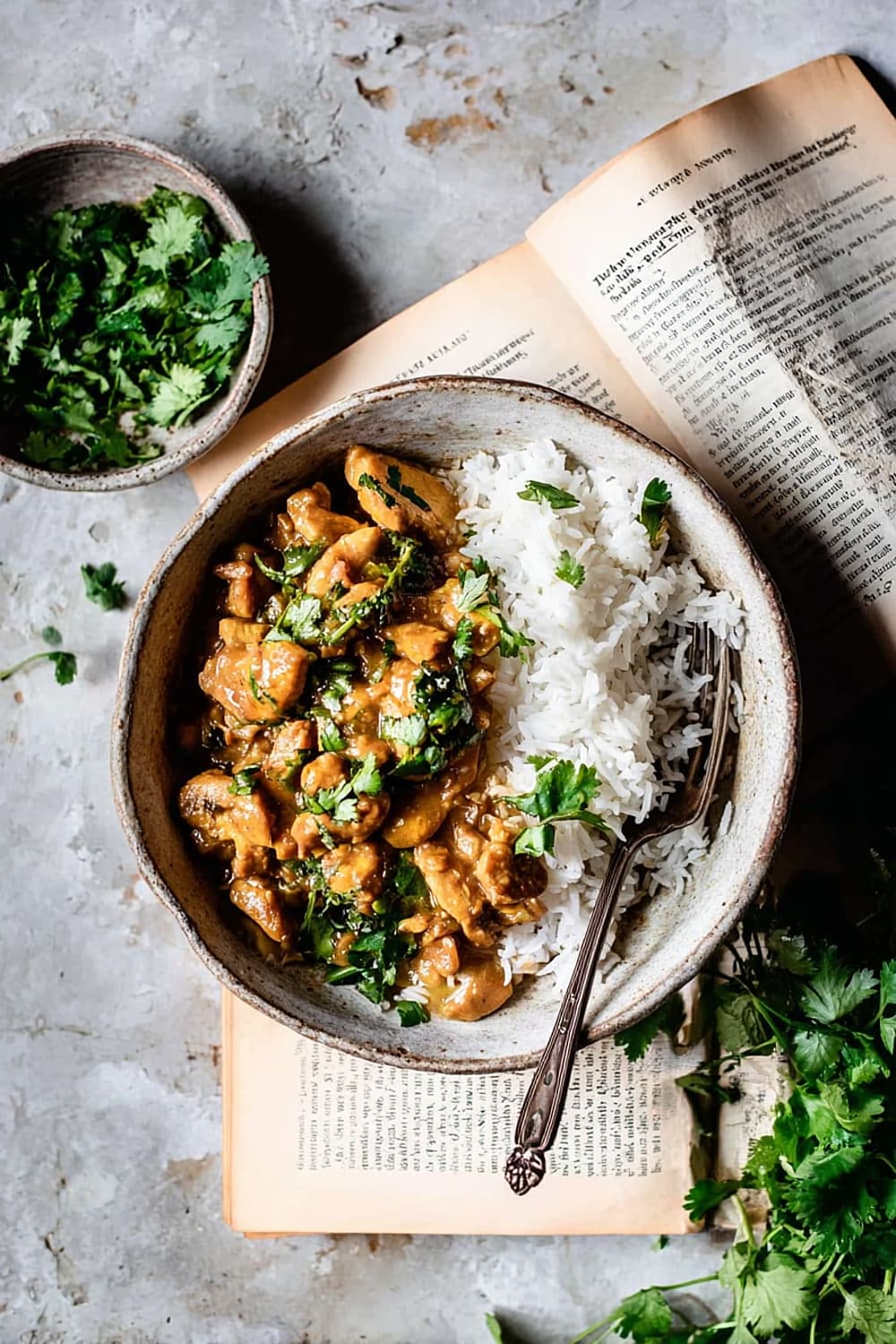
Ingredients
For the Curry Paste
- 1 stalk lemongrass, minced
- 1 piece ginger (2 inches), peeled
- 1 tablespoon fish sauce
- 2 teaspoons garam masala
- 1 shallot, roughly chopped
- 3 cloves garlic, peeled
- 2 tablespoons vegetable oil
For the Curry
- 2 tablespoons coconut sugar
- ¼ teaspoon shrimp paste (optional but recommended)
- 1 pound chicken thighs, cut into 1-inch pieces
- ¼ cup coconut milk
- ¼ cup water
- Salt and pepper to taste
For Garnish
- 1 tablespoon fresh cilantro, minced
- Steamed jasmine rice for serving
Instructions
Prepare the Curry Paste
- 1 Add the minced lemongrass, 2-inch piece of ginger, 1 tablespoon fish sauce, 2 teaspoons garam masala, chopped shallot, 3 garlic cloves, and 2 tablespoons vegetable oil to your food processor. Using a food processor ensures you get that perfectly smooth paste that’s essential for authentic Burmese curry – no chunky bits to interrupt the silky sauce.
- 2 Pulse the mixture for approximately 3 minutes until a thick, fragrant paste forms. The paste should be smooth and cohesive, with no large pieces of ginger or lemongrass visible. If the mixture seems too dry, add an extra teaspoon of vegetable oil to help it come together. Set this aromatic paste aside while you prepare the chicken.
Prepare the Chicken
- 3 Season the 1 pound of chicken thigh pieces generously with salt and pepper on all sides. Chicken thighs are crucial here because they stay tender and juicy during the quick cooking process, unlike chicken breast which can easily become dry. The 1-inch pieces ensure even cooking and perfect bite-sized portions.
Cook the Curry
- 4 Heat your non-stick pan over medium-high heat and add the prepared curry paste. Cook for exactly 20 seconds until the paste becomes incredibly fragrant and you can smell the lemongrass and ginger blooming. This brief cooking time activates the aromatics without burning the delicate flavors – any longer and you risk bitter notes.
- 5 Immediately add the 2 tablespoons coconut sugar, ¼ teaspoon shrimp paste (if using), and the seasoned chicken pieces to the pan. Cook for 2-3 minutes, stirring frequently to ensure the chicken browns evenly on all sides. The coconut sugar will start to caramelize slightly, creating depth and balancing the savory elements.
- 6 Pour in the ¼ cup coconut milk and ¼ cup water, stirring to combine all ingredients. Bring the mixture to a vigorous boil – you’ll see bubbles forming across the entire surface. This initial boil helps emulsify the coconut milk with the curry paste.
Finish and Serve
- 7 Reduce the heat to medium-low and let the curry simmer for exactly 3 minutes. During this time, the liquid will reduce and thicken into a glossy, coating consistency. The chicken should reach an internal temperature of 165°F (74°C) and the sauce should coat the back of a spoon.
- 8 Remove from heat and garnish with 1 tablespoon minced fresh cilantro. Serve immediately over steamed jasmine rice while the curry is hot and the aromatics are at their peak intensity.
Recommended Equipment and Kitchen Tools
Essential Tools (for best results)
- Food processor – Creates the perfectly smooth curry paste that’s impossible to achieve by hand. The uniform texture ensures even flavor distribution throughout the curry.
- Non-stick pan or cast iron skillet – Prevents the curry paste from sticking during the initial cooking phase and allows for even browning of the chicken pieces.
- Wooden spoon or silicone spatula – Won’t scratch your pan surface and handles the thick curry paste without breaking down.
- Sharp chef’s knife – Essential for cleanly cutting chicken thighs into uniform pieces and mincing aromatics.
Helpful Upgrades
- Digital kitchen scale – Measuring ingredients by weight ensures consistent results, especially important for the curry paste ratios.
- Microplane grater – Perfect for grating fresh ginger if you prefer an ultra-smooth paste texture.
- Instant-read thermometer – Takes the guesswork out of ensuring your chicken reaches the safe internal temperature.
Nice-to-Have Options
- Mortar and pestle – Traditional method for making curry paste if you want to go completely authentic, though it requires significantly more effort.
- Fine-mesh strainer – Useful if you want an ultra-smooth sauce, though not necessary for this rustic-style curry.
Recipe Variations and Dietary Modifications
Protein Variations
- Beef or pork → Use 1 pound cubed beef chuck or pork shoulder, increase cooking time to 8-10 minutes for proper tenderness
- Seafood version → Replace with 1 pound large shrimp or firm white fish, reduce cooking time to 1-2 minutes to prevent overcooking
- Vegetarian option → Substitute 1 pound firm tofu or mixed vegetables like eggplant and bell peppers
Spice Level Adjustments
- Mild version → Reduce garam masala to 1 teaspoon, omit shrimp paste entirely
- Spicy kick → Add 1-2 Thai chilies to the curry paste or ½ teaspoon red pepper flakes
- Extra aromatic → Double the lemongrass and ginger for more citrusy brightness
Coconut Milk Alternatives
- Lighter version → Use light coconut milk or mix 2 tablespoons coconut cream with 2 tablespoons water
- Dairy-free richness → Add 1 tablespoon cashew butter for creaminess without coconut
- Traditional approach → Use fresh coconut milk if available for authentic flavor
Sweetener Substitutions
- Refined sugar-free → Replace coconut sugar with 2 tablespoons palm sugar or 1 tablespoon honey
- Low-carb option → Use 1 tablespoon erythritol or monk fruit sweetener to taste
Nutritional Information and Health Benefits
Key Nutritional Highlights
This Burmese chicken curry provides approximately 320 calories per serving, with a balanced macronutrient profile of 28 grams protein, 12 grams fat, and 18 grams carbohydrates. The chicken thighs contribute high-quality complete protein essential for muscle maintenance, while the coconut milk provides healthy medium-chain triglycerides that support metabolism.
Health Benefits of Main Ingredients
Lemongrass contains citral, a powerful antioxidant compound with anti-inflammatory properties that may help reduce oxidative stress. Fresh ginger provides gingerol, known for its digestive benefits and natural anti-nausea properties. Garam masala is a blend of warming spices like cinnamon, cardamom, and cloves, each contributing unique antioxidants and potential anti-inflammatory benefits. Fish sauce adds umami depth while providing essential amino acids and B vitamins.
Dietary Considerations
This recipe is naturally gluten-free and dairy-free, making it suitable for those with common food sensitivities. The curry contains fish sauce and optional shrimp paste, so it’s not suitable for vegetarians or those with shellfish allergies. Each serving provides approximately 4 grams of fiber from the aromatics and spices, supporting digestive health. The moderate sodium content makes it appropriate for most dietary patterns when served with plain rice.
Smart Swaps and Ingredient Substitutions
Common Substitutions:
- Lemongrass → 2 teaspoons lemon zest plus 1 tablespoon lemon juice for citrusy brightness without the grass-like notes
- Fresh ginger → 1 teaspoon ground ginger, though fresh provides superior flavor and aroma
- Fish sauce → 2 tablespoons soy sauce plus 1 teaspoon anchovy paste for similar umami depth
- Garam masala → 1 teaspoon curry powder plus ½ teaspoon cinnamon and ¼ teaspoon cardamom
Budget-Friendly Swaps:
- Coconut sugar → Regular brown sugar or white sugar works equally well for sweetness and caramelization
- Shallot → ¼ cup yellow onion provides similar aromatic base at lower cost
- Coconut milk → Whole milk plus 2 tablespoons melted butter creates richness without coconut flavor
Pantry Emergency Substitutions:
- Fresh garlic → 1 teaspoon garlic powder, though fresh is strongly preferred for curry paste
- Vegetable oil → Peanut oil or canola oil work equally well for the paste base
- Fresh cilantro → Fresh parsley or Thai basil for different but complementary herb notes
Pro Tips for Substitutions:
- When using dried spices instead of fresh aromatics, reduce quantities by half and add them earlier in the cooking process for better flavor development
- Store leftover curry paste in the refrigerator for up to 5 days or freeze in ice cube trays for future use
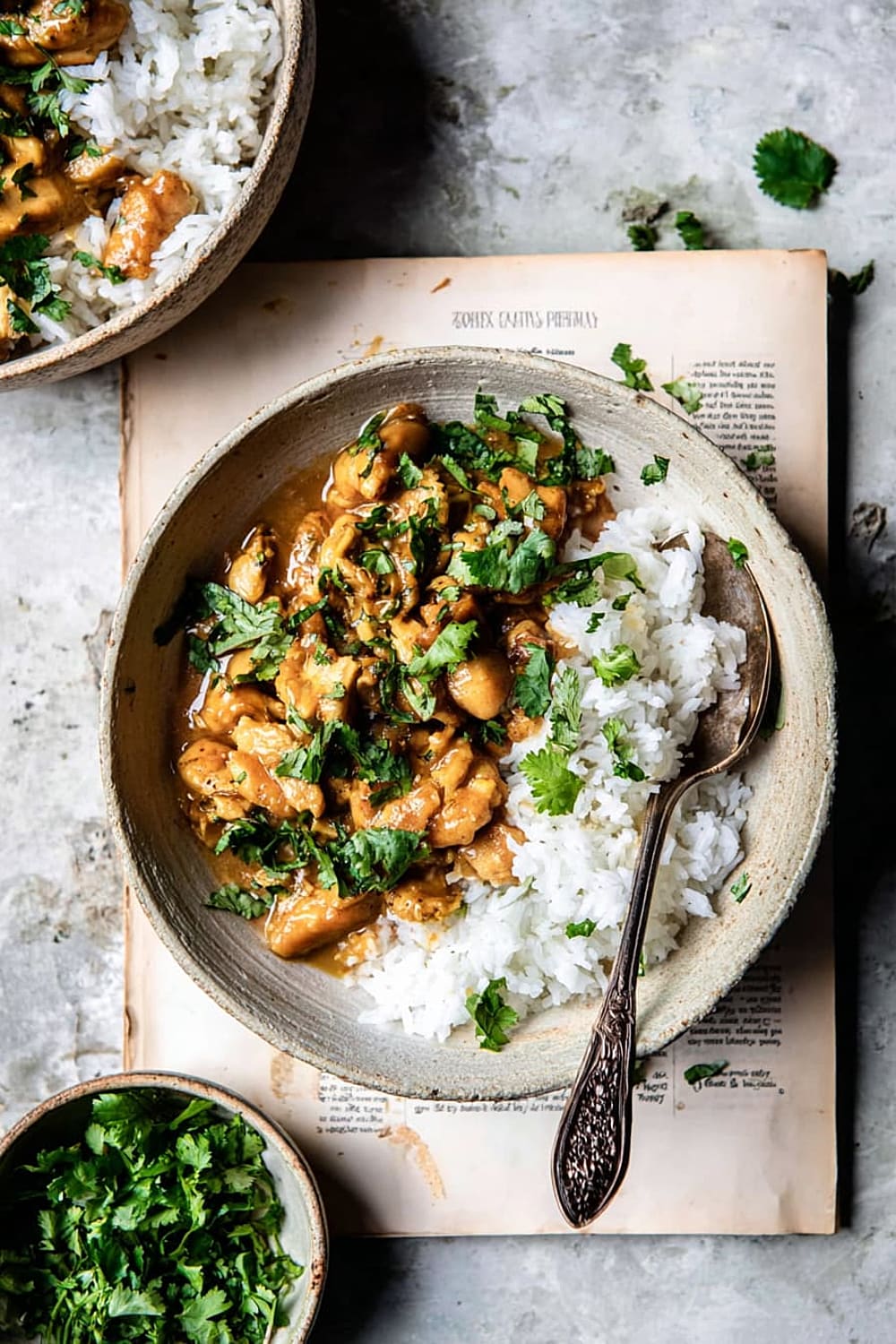
Make It Diabetes-Friendly
Sugar Substitutions:
- Replace 2 tablespoons coconut sugar with 1 tablespoon erythritol or stevia equivalent to reduce carbs by approximately 12 grams
- Monk fruit sweetener works exceptionally well in curries, providing sweetness without affecting blood glucose
- Consider using 1 tablespoon unsweetened applesauce for natural sweetness with added fiber
Carb Reduction Strategies:
- Serve over cauliflower rice instead of jasmine rice to reduce total meal carbs from 45 grams to 8 grams
- Shirataki noodles or zucchini noodles make excellent low-carb alternatives to traditional rice
- Add extra vegetables like bell peppers or broccoli to increase volume without significantly impacting carbs
Portion & Timing Tips:
- Recommended serving size: ¾ cup curry with ½ cup cauliflower rice contains approximately 6 grams net carbs
- Pair with 2 tablespoons chopped peanuts for healthy fats that help slow glucose absorption
- Estimated carb content of modified version: 8-10 grams compared to 18 grams in original recipe
Total Carb Reduction: Modified version reduces carbohydrates by approximately 55% while maintaining authentic Burmese flavors and satisfying protein content.
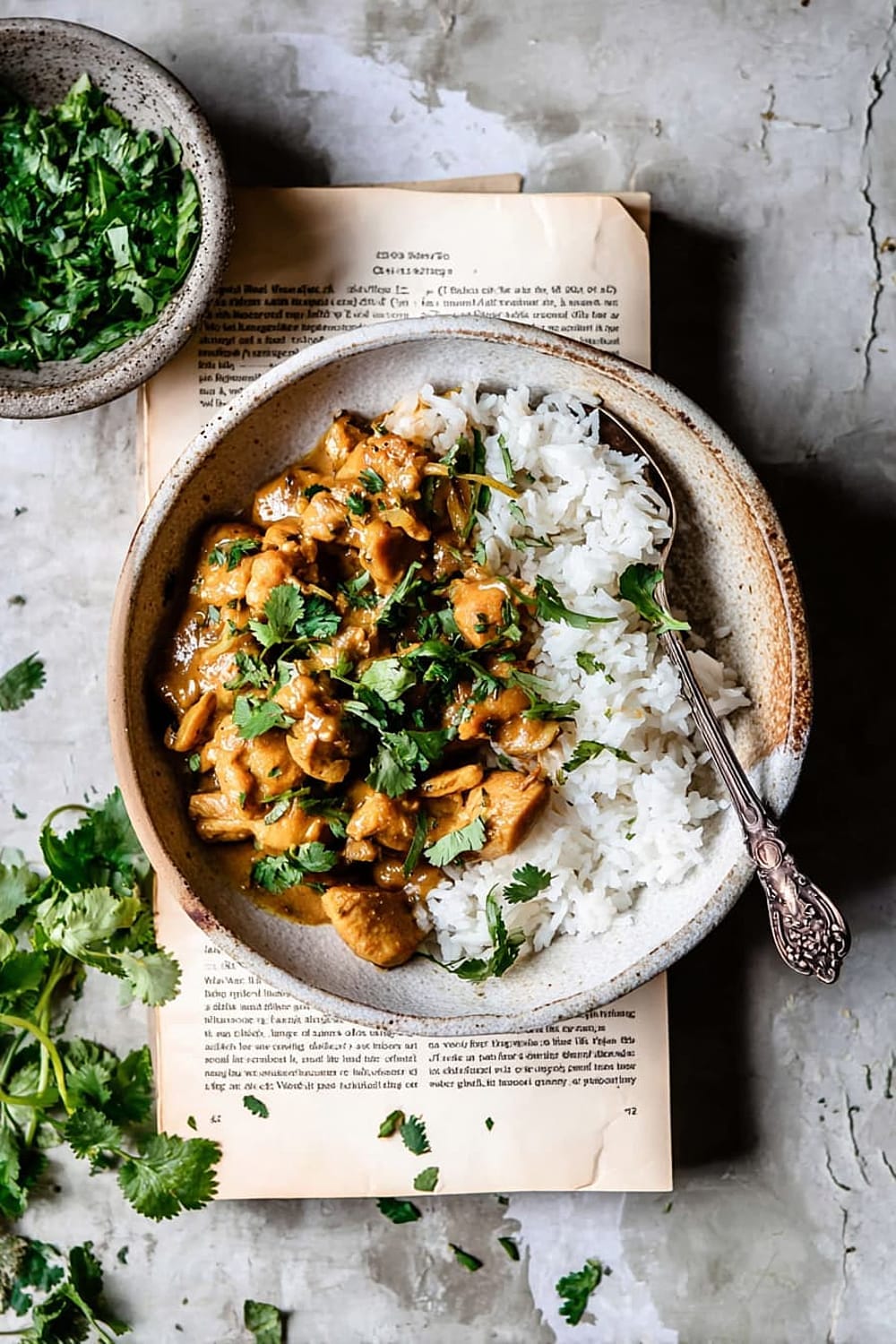
Perfect Pairing Suggestions
Beverage Pairings
Riesling or Gewürztraminer complement the aromatic spices beautifully, while their slight sweetness balances the curry’s heat. For beer lovers, a wheat beer or Belgian witbier provides refreshing contrast to the rich coconut milk. Thai iced tea or coconut water offer non-alcoholic options that enhance the Southeast Asian theme. Green jasmine tea served hot cleanses the palate between bites.
Side Dish Recommendations
Cucumber salad with rice vinegar dressing provides cooling crunch that contrasts the warm, creamy curry. Steamed bok choy or Chinese broccoli add nutritious greens without competing flavors. Coconut rice made with light coconut milk amplifies the tropical notes, while brown jasmine rice contributes nutty flavor and extra fiber. Fresh spring rolls with mint and cilantro create a complete Southeast Asian feast.
Complete Meal Ideas
Start with tom kha soup or fresh papaya salad to awaken the palate. The curry serves as an excellent centerpiece alongside pad thai or Vietnamese summer rolls for variety. Finish with mango sticky rice or coconut panna cotta to continue the tropical theme. For entertaining, serve family-style with multiple small dishes encouraging sharing and exploration.
Occasion Suggestions
Perfect for casual weeknight dinners when you want something special without extensive prep time. Ideal for dinner parties where you want to introduce guests to authentic Southeast Asian flavors. The aromatic qualities make it wonderful for cold weather comfort food, while the fresh herbs keep it appropriate for summer entertaining.
Pro Tips and Troubleshooting
Professional Techniques
Toast the garam masala in a dry pan for 30 seconds before adding to the curry paste – this blooms the spices and intensifies their flavor significantly. When mincing lemongrass, use only the tender inner portions and pound them lightly with the flat side of your knife to release maximum oils. Room temperature chicken cooks more evenly than cold chicken straight from the refrigerator.
Common Mistake Prevention
Never let the curry paste burn during the initial 20-second cooking phase – burnt aromatics create bitter flavors that can’t be corrected. Don’t skip the simmering step; the 3-minute reduction time is crucial for proper sauce consistency and flavor concentration. Avoid using chicken breast as it becomes dry and stringy in this quick-cooking method.
Storage and Reheating
Store leftover curry in the refrigerator for up to 4 days in airtight containers. The flavors actually improve overnight as they meld together. Reheat gently over low heat, adding 1-2 tablespoons water if the sauce has thickened too much. Freeze for up to 3 months, though the coconut milk may separate slightly upon thawing.
Make-Ahead Strategies
Prepare the curry paste up to 3 days in advance and store refrigerated. The complete curry can be made 1 day ahead and reheated, often with improved flavor development. For meal prep, portion into individual containers with rice for grab-and-go lunches.
Recipe Scaling
This recipe doubles easily for larger groups – just use a larger pan to ensure proper browning. When halving, maintain the same cooking times but watch the liquid reduction more carefully in smaller quantities.
This curry proves that incredible flavor doesn’t require hours of preparation or a pantry full of exotic ingredients. With just 30 minutes and a handful of aromatic ingredients, you’ve created something that tastes like it came from your favorite Thai restaurant – except better, because you made it yourself and can take all the credit when people inevitably ask for the recipe.